Critical Analysis: CSE Anesthesia and Hypotension in Cesarean Delivery
VerifiedAdded on 2021/04/17
|11
|3139
|65
Report
AI Summary
This report presents a critical analysis of a research paper that investigates the effects of combined spinal-epidural anesthesia (CSE) on maternal hypotension during cesarean deliveries. The study compares the sitting versus right lateral positions for anesthesia administration, examining block characteristics and the severity of hypotension. The analysis evaluates the study's rationale, search strategy, inclusion and exclusion criteria, and ethical considerations. It critiques the study's methodology, including sample size, blinding, and statistical analysis. The report also discusses the physiological implications of hypotension, the role of nurses in patient care, and the potential benefits of the sitting position in reducing adverse outcomes. Ultimately, the analysis concludes that the CSE technique in a sitting position may lead to better anesthetic blocks and reduced hypotension in cesarean patients, supporting the need for further research and clinical application of these findings. The report emphasizes that the findings of this study will be helpful for healthcare professionals towards improving surgical settings in cesarean delivery. This document is a past paper available on Desklib, a platform providing study tools for students.
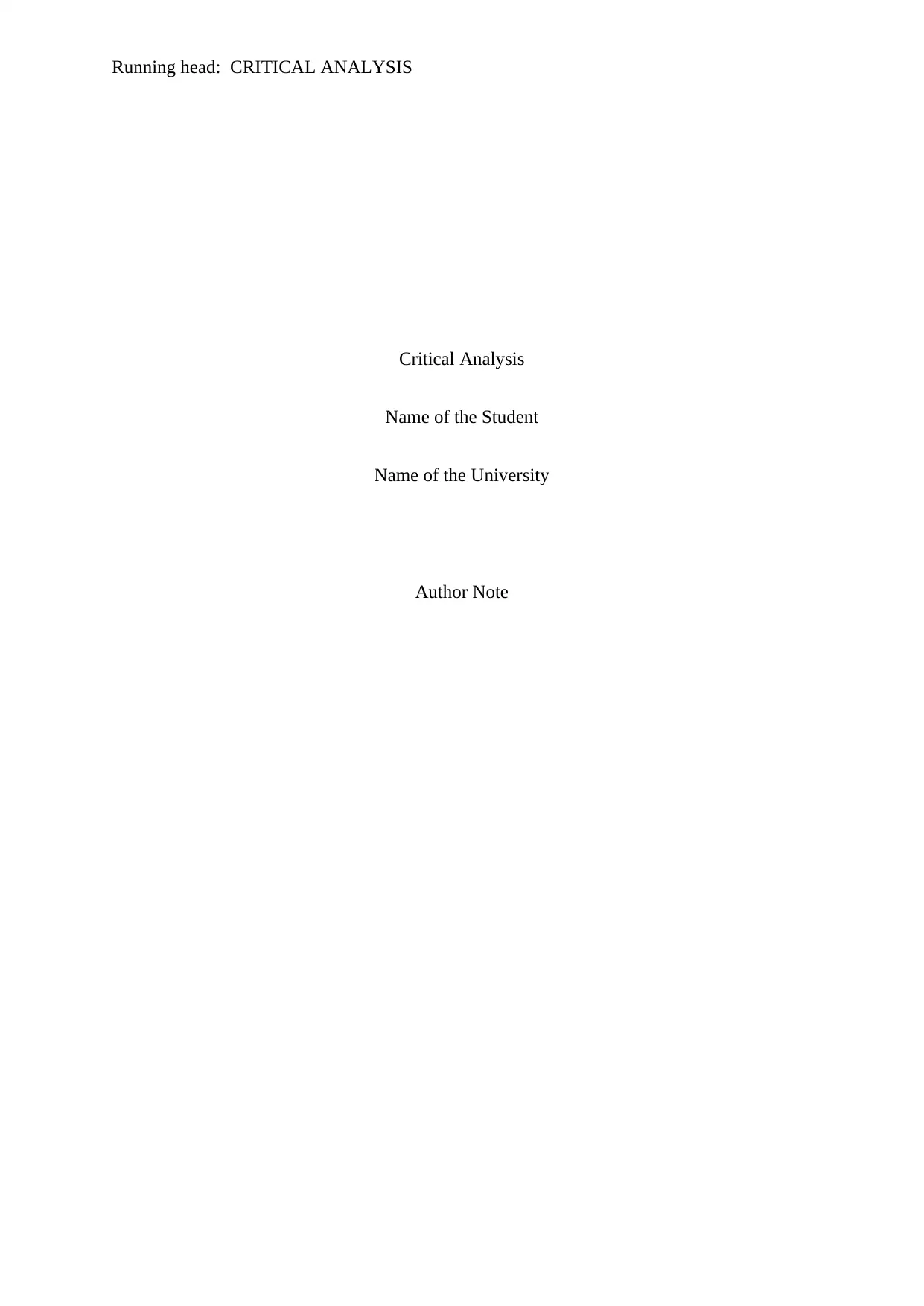
Running head: CRITICAL ANALYSIS
Critical Analysis
Name of the Student
Name of the University
Author Note
Critical Analysis
Name of the Student
Name of the University
Author Note
Paraphrase This Document
Need a fresh take? Get an instant paraphrase of this document with our AI Paraphraser

1
CRITICAL ANALYSIS
The Sitting Versus Right Lateral Position During Combined Spinal-Epidural Anesthesia for
Cesarean Delivery: Block Characteristics and Severity of Hypotension
Introduction: Rationale and Justification
One of the common phenomenon encountered in cesarean delivery is hypotension
among the expecting mother upon the administration of combined spinal-epiduralanesthesia
(CSE) (Oh et al. 2014). Imbalance in maternal blood pressure is associated with poor
pregnancy outcome along with the occurrence of the fetal distress and stillbirth (Mercier et al.
2013). The most commonly used process in surgical maternity care or anesthesia is combined
spinal-epiduralanesthesia (CSE) in lateral position. However, spinal anesthesia is commonly
associated with the maternal hypotension (Wang et al. 2015). However, anesthesia is crucial
before the initiation of the cesarean delivery (Simmons et al. 2012).
The assignment aims to provide critical analysis of a paper, which is based on the
effect of combined spinal-epiduralanesthesia (CSE) on maternal hypotension. The findings of
the study will be helpful for the surgical health care professionals towards improving surgical
settings in cesesearean delivery. The results will also be helpful for the nurses to provide
quality care to their patients and at the same time will be helpful for the doctors to reduce the
possible threats coming from the maternal hypotension to the baby and te mother.
Search strategy
The review of literature was conducted based on the relevant articles, which were
selected from the PubMed database electronically. The principal keywords that are used for
the search include cesarean delivery AND spinal-epiduralanesthesia (CSE) AND hypotension
AND right lateral position AND sitting position AND Other associated keywords include,
randomized study AND anesthesia. Only studies, which are designed over the human placebo
during the last 20 years, were chosen for the study. According to Parahoo et al. (2006) the
CRITICAL ANALYSIS
The Sitting Versus Right Lateral Position During Combined Spinal-Epidural Anesthesia for
Cesarean Delivery: Block Characteristics and Severity of Hypotension
Introduction: Rationale and Justification
One of the common phenomenon encountered in cesarean delivery is hypotension
among the expecting mother upon the administration of combined spinal-epiduralanesthesia
(CSE) (Oh et al. 2014). Imbalance in maternal blood pressure is associated with poor
pregnancy outcome along with the occurrence of the fetal distress and stillbirth (Mercier et al.
2013). The most commonly used process in surgical maternity care or anesthesia is combined
spinal-epiduralanesthesia (CSE) in lateral position. However, spinal anesthesia is commonly
associated with the maternal hypotension (Wang et al. 2015). However, anesthesia is crucial
before the initiation of the cesarean delivery (Simmons et al. 2012).
The assignment aims to provide critical analysis of a paper, which is based on the
effect of combined spinal-epiduralanesthesia (CSE) on maternal hypotension. The findings of
the study will be helpful for the surgical health care professionals towards improving surgical
settings in cesesearean delivery. The results will also be helpful for the nurses to provide
quality care to their patients and at the same time will be helpful for the doctors to reduce the
possible threats coming from the maternal hypotension to the baby and te mother.
Search strategy
The review of literature was conducted based on the relevant articles, which were
selected from the PubMed database electronically. The principal keywords that are used for
the search include cesarean delivery AND spinal-epiduralanesthesia (CSE) AND hypotension
AND right lateral position AND sitting position AND Other associated keywords include,
randomized study AND anesthesia. Only studies, which are designed over the human placebo
during the last 20 years, were chosen for the study. According to Parahoo et al. (2006) the
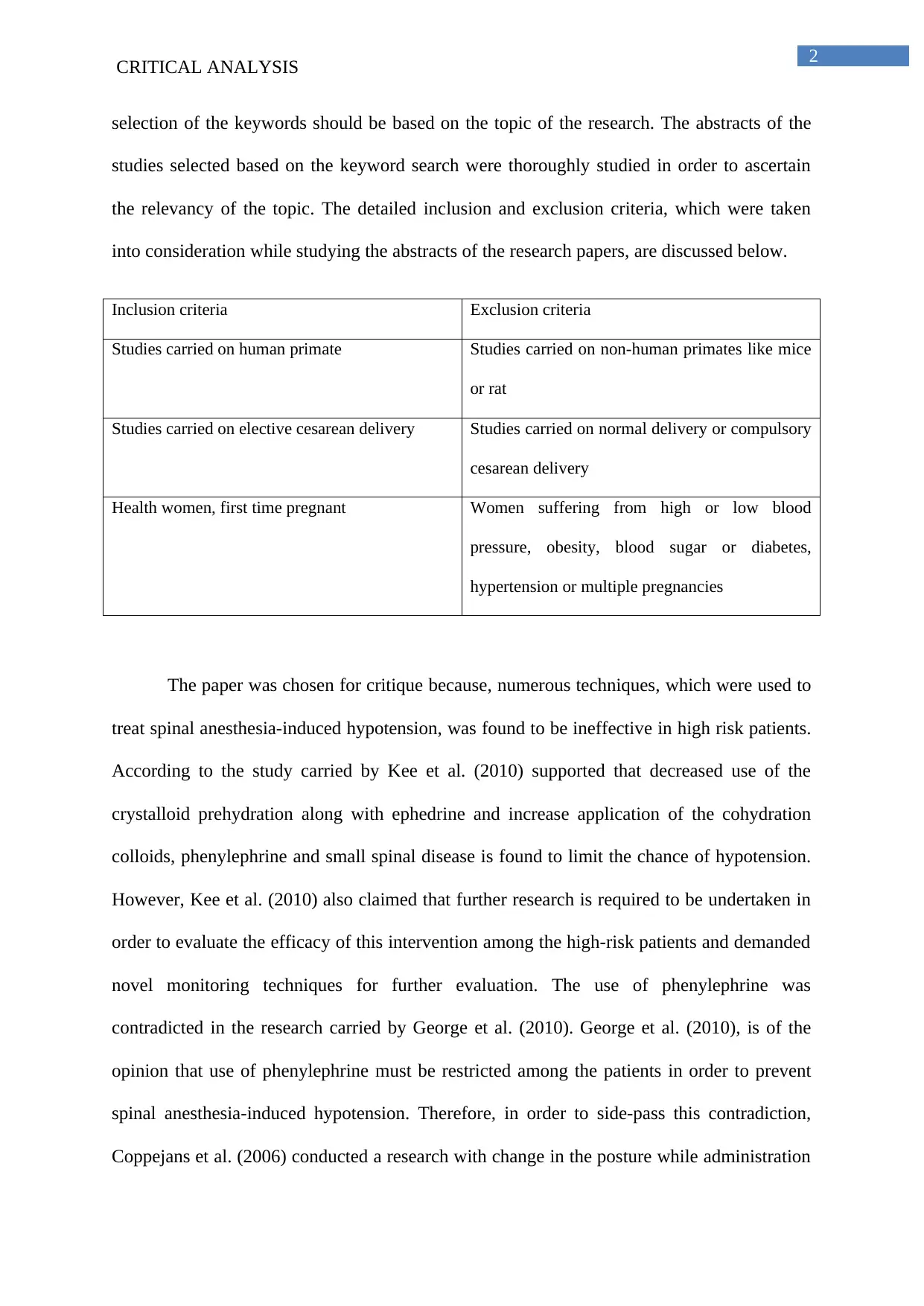
2
CRITICAL ANALYSIS
selection of the keywords should be based on the topic of the research. The abstracts of the
studies selected based on the keyword search were thoroughly studied in order to ascertain
the relevancy of the topic. The detailed inclusion and exclusion criteria, which were taken
into consideration while studying the abstracts of the research papers, are discussed below.
Inclusion criteria Exclusion criteria
Studies carried on human primate Studies carried on non-human primates like mice
or rat
Studies carried on elective cesarean delivery Studies carried on normal delivery or compulsory
cesarean delivery
Health women, first time pregnant Women suffering from high or low blood
pressure, obesity, blood sugar or diabetes,
hypertension or multiple pregnancies
The paper was chosen for critique because, numerous techniques, which were used to
treat spinal anesthesia-induced hypotension, was found to be ineffective in high risk patients.
According to the study carried by Kee et al. (2010) supported that decreased use of the
crystalloid prehydration along with ephedrine and increase application of the cohydration
colloids, phenylephrine and small spinal disease is found to limit the chance of hypotension.
However, Kee et al. (2010) also claimed that further research is required to be undertaken in
order to evaluate the efficacy of this intervention among the high-risk patients and demanded
novel monitoring techniques for further evaluation. The use of phenylephrine was
contradicted in the research carried by George et al. (2010). George et al. (2010), is of the
opinion that use of phenylephrine must be restricted among the patients in order to prevent
spinal anesthesia-induced hypotension. Therefore, in order to side-pass this contradiction,
Coppejans et al. (2006) conducted a research with change in the posture while administration
CRITICAL ANALYSIS
selection of the keywords should be based on the topic of the research. The abstracts of the
studies selected based on the keyword search were thoroughly studied in order to ascertain
the relevancy of the topic. The detailed inclusion and exclusion criteria, which were taken
into consideration while studying the abstracts of the research papers, are discussed below.
Inclusion criteria Exclusion criteria
Studies carried on human primate Studies carried on non-human primates like mice
or rat
Studies carried on elective cesarean delivery Studies carried on normal delivery or compulsory
cesarean delivery
Health women, first time pregnant Women suffering from high or low blood
pressure, obesity, blood sugar or diabetes,
hypertension or multiple pregnancies
The paper was chosen for critique because, numerous techniques, which were used to
treat spinal anesthesia-induced hypotension, was found to be ineffective in high risk patients.
According to the study carried by Kee et al. (2010) supported that decreased use of the
crystalloid prehydration along with ephedrine and increase application of the cohydration
colloids, phenylephrine and small spinal disease is found to limit the chance of hypotension.
However, Kee et al. (2010) also claimed that further research is required to be undertaken in
order to evaluate the efficacy of this intervention among the high-risk patients and demanded
novel monitoring techniques for further evaluation. The use of phenylephrine was
contradicted in the research carried by George et al. (2010). George et al. (2010), is of the
opinion that use of phenylephrine must be restricted among the patients in order to prevent
spinal anesthesia-induced hypotension. Therefore, in order to side-pass this contradiction,
Coppejans et al. (2006) conducted a research with change in the posture while administration
⊘ This is a preview!⊘
Do you want full access?
Subscribe today to unlock all pages.

Trusted by 1+ million students worldwide
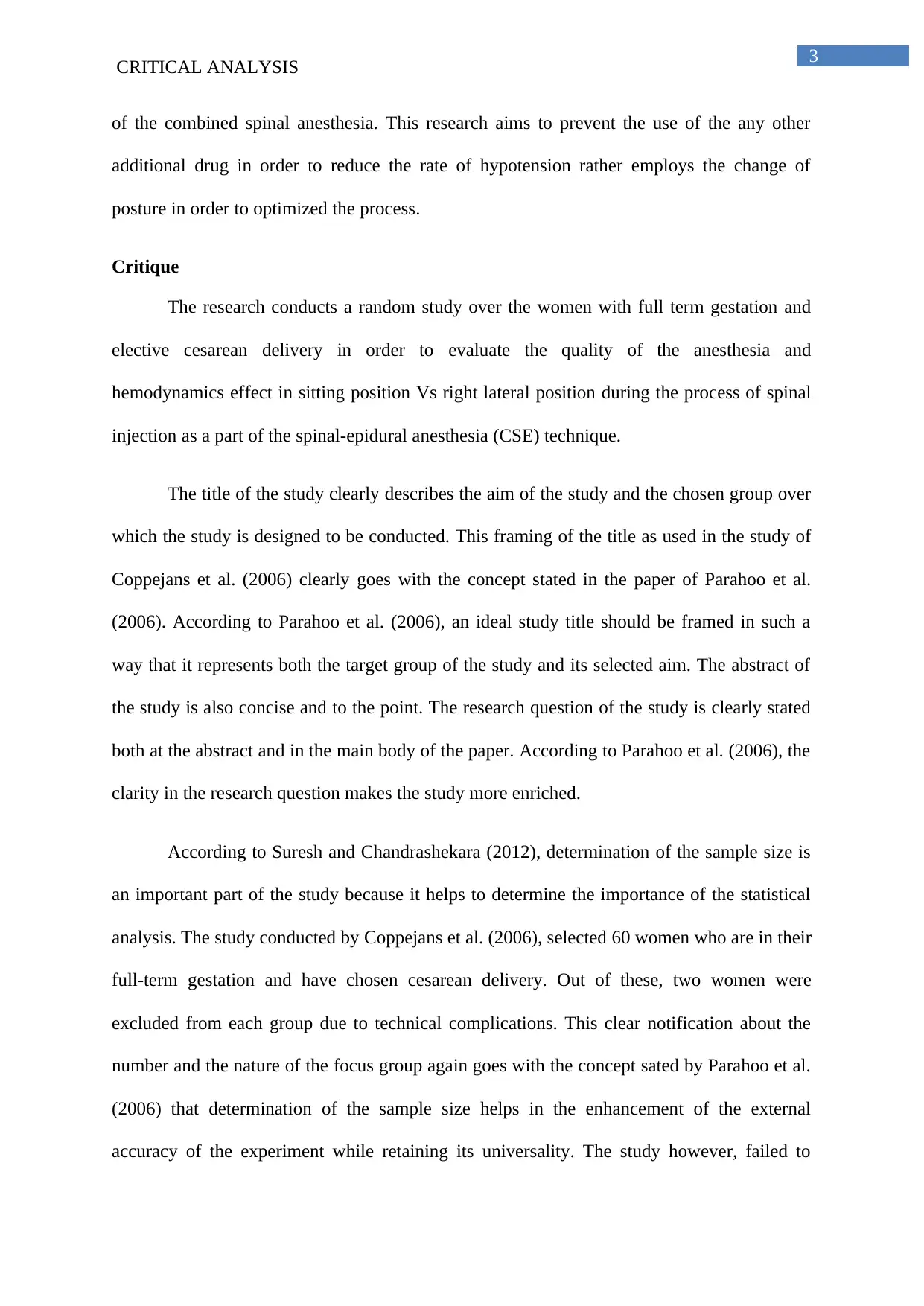
3
CRITICAL ANALYSIS
of the combined spinal anesthesia. This research aims to prevent the use of the any other
additional drug in order to reduce the rate of hypotension rather employs the change of
posture in order to optimized the process.
Critique
The research conducts a random study over the women with full term gestation and
elective cesarean delivery in order to evaluate the quality of the anesthesia and
hemodynamics effect in sitting position Vs right lateral position during the process of spinal
injection as a part of the spinal-epidural anesthesia (CSE) technique.
The title of the study clearly describes the aim of the study and the chosen group over
which the study is designed to be conducted. This framing of the title as used in the study of
Coppejans et al. (2006) clearly goes with the concept stated in the paper of Parahoo et al.
(2006). According to Parahoo et al. (2006), an ideal study title should be framed in such a
way that it represents both the target group of the study and its selected aim. The abstract of
the study is also concise and to the point. The research question of the study is clearly stated
both at the abstract and in the main body of the paper. According to Parahoo et al. (2006), the
clarity in the research question makes the study more enriched.
According to Suresh and Chandrashekara (2012), determination of the sample size is
an important part of the study because it helps to determine the importance of the statistical
analysis. The study conducted by Coppejans et al. (2006), selected 60 women who are in their
full-term gestation and have chosen cesarean delivery. Out of these, two women were
excluded from each group due to technical complications. This clear notification about the
number and the nature of the focus group again goes with the concept sated by Parahoo et al.
(2006) that determination of the sample size helps in the enhancement of the external
accuracy of the experiment while retaining its universality. The study however, failed to
CRITICAL ANALYSIS
of the combined spinal anesthesia. This research aims to prevent the use of the any other
additional drug in order to reduce the rate of hypotension rather employs the change of
posture in order to optimized the process.
Critique
The research conducts a random study over the women with full term gestation and
elective cesarean delivery in order to evaluate the quality of the anesthesia and
hemodynamics effect in sitting position Vs right lateral position during the process of spinal
injection as a part of the spinal-epidural anesthesia (CSE) technique.
The title of the study clearly describes the aim of the study and the chosen group over
which the study is designed to be conducted. This framing of the title as used in the study of
Coppejans et al. (2006) clearly goes with the concept stated in the paper of Parahoo et al.
(2006). According to Parahoo et al. (2006), an ideal study title should be framed in such a
way that it represents both the target group of the study and its selected aim. The abstract of
the study is also concise and to the point. The research question of the study is clearly stated
both at the abstract and in the main body of the paper. According to Parahoo et al. (2006), the
clarity in the research question makes the study more enriched.
According to Suresh and Chandrashekara (2012), determination of the sample size is
an important part of the study because it helps to determine the importance of the statistical
analysis. The study conducted by Coppejans et al. (2006), selected 60 women who are in their
full-term gestation and have chosen cesarean delivery. Out of these, two women were
excluded from each group due to technical complications. This clear notification about the
number and the nature of the focus group again goes with the concept sated by Parahoo et al.
(2006) that determination of the sample size helps in the enhancement of the external
accuracy of the experiment while retaining its universality. The study however, failed to
Paraphrase This Document
Need a fresh take? Get an instant paraphrase of this document with our AI Paraphraser
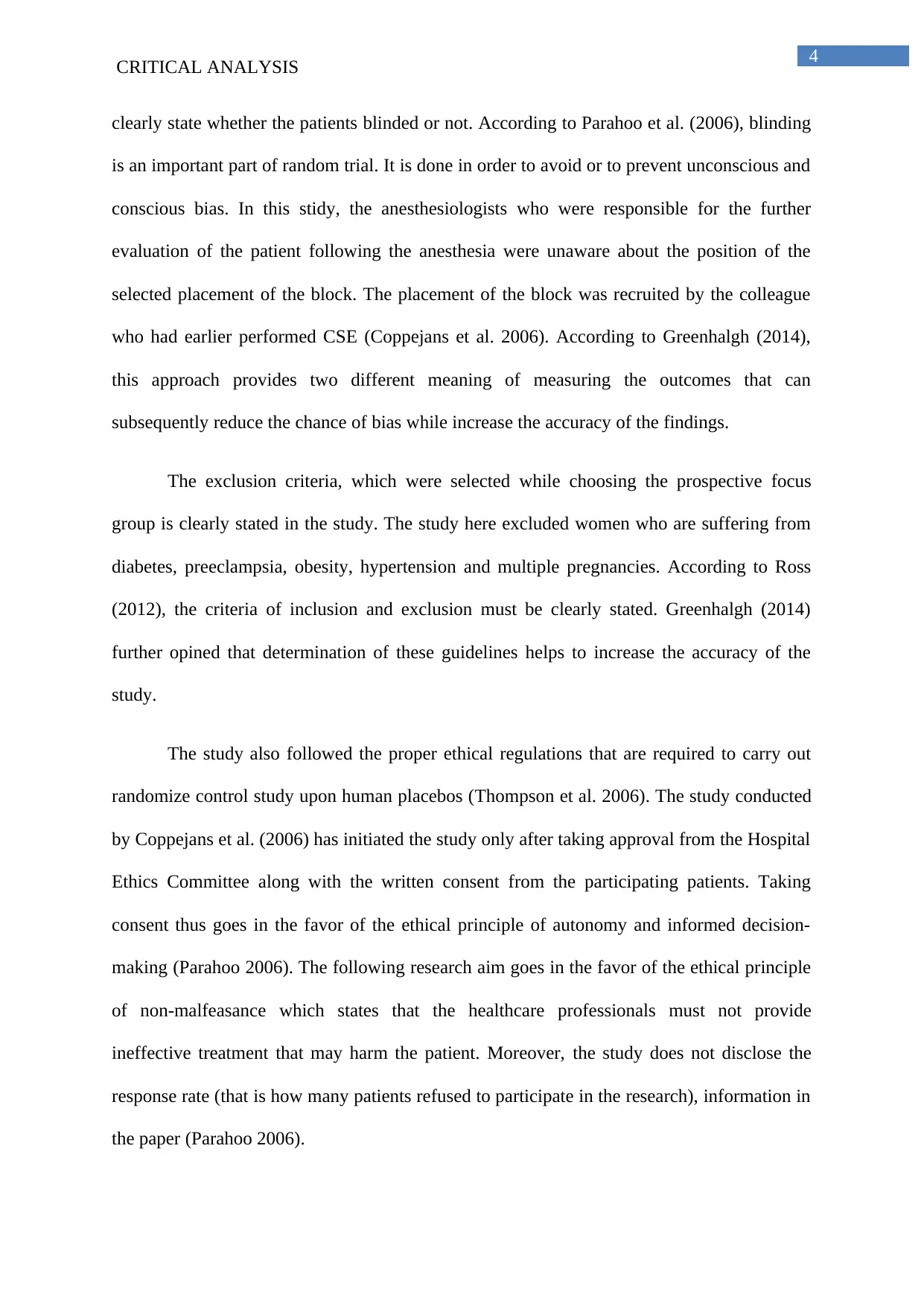
4
CRITICAL ANALYSIS
clearly state whether the patients blinded or not. According to Parahoo et al. (2006), blinding
is an important part of random trial. It is done in order to avoid or to prevent unconscious and
conscious bias. In this stidy, the anesthesiologists who were responsible for the further
evaluation of the patient following the anesthesia were unaware about the position of the
selected placement of the block. The placement of the block was recruited by the colleague
who had earlier performed CSE (Coppejans et al. 2006). According to Greenhalgh (2014),
this approach provides two different meaning of measuring the outcomes that can
subsequently reduce the chance of bias while increase the accuracy of the findings.
The exclusion criteria, which were selected while choosing the prospective focus
group is clearly stated in the study. The study here excluded women who are suffering from
diabetes, preeclampsia, obesity, hypertension and multiple pregnancies. According to Ross
(2012), the criteria of inclusion and exclusion must be clearly stated. Greenhalgh (2014)
further opined that determination of these guidelines helps to increase the accuracy of the
study.
The study also followed the proper ethical regulations that are required to carry out
randomize control study upon human placebos (Thompson et al. 2006). The study conducted
by Coppejans et al. (2006) has initiated the study only after taking approval from the Hospital
Ethics Committee along with the written consent from the participating patients. Taking
consent thus goes in the favor of the ethical principle of autonomy and informed decision-
making (Parahoo 2006). The following research aim goes in the favor of the ethical principle
of non-malfeasance which states that the healthcare professionals must not provide
ineffective treatment that may harm the patient. Moreover, the study does not disclose the
response rate (that is how many patients refused to participate in the research), information in
the paper (Parahoo 2006).
CRITICAL ANALYSIS
clearly state whether the patients blinded or not. According to Parahoo et al. (2006), blinding
is an important part of random trial. It is done in order to avoid or to prevent unconscious and
conscious bias. In this stidy, the anesthesiologists who were responsible for the further
evaluation of the patient following the anesthesia were unaware about the position of the
selected placement of the block. The placement of the block was recruited by the colleague
who had earlier performed CSE (Coppejans et al. 2006). According to Greenhalgh (2014),
this approach provides two different meaning of measuring the outcomes that can
subsequently reduce the chance of bias while increase the accuracy of the findings.
The exclusion criteria, which were selected while choosing the prospective focus
group is clearly stated in the study. The study here excluded women who are suffering from
diabetes, preeclampsia, obesity, hypertension and multiple pregnancies. According to Ross
(2012), the criteria of inclusion and exclusion must be clearly stated. Greenhalgh (2014)
further opined that determination of these guidelines helps to increase the accuracy of the
study.
The study also followed the proper ethical regulations that are required to carry out
randomize control study upon human placebos (Thompson et al. 2006). The study conducted
by Coppejans et al. (2006) has initiated the study only after taking approval from the Hospital
Ethics Committee along with the written consent from the participating patients. Taking
consent thus goes in the favor of the ethical principle of autonomy and informed decision-
making (Parahoo 2006). The following research aim goes in the favor of the ethical principle
of non-malfeasance which states that the healthcare professionals must not provide
ineffective treatment that may harm the patient. Moreover, the study does not disclose the
response rate (that is how many patients refused to participate in the research), information in
the paper (Parahoo 2006).
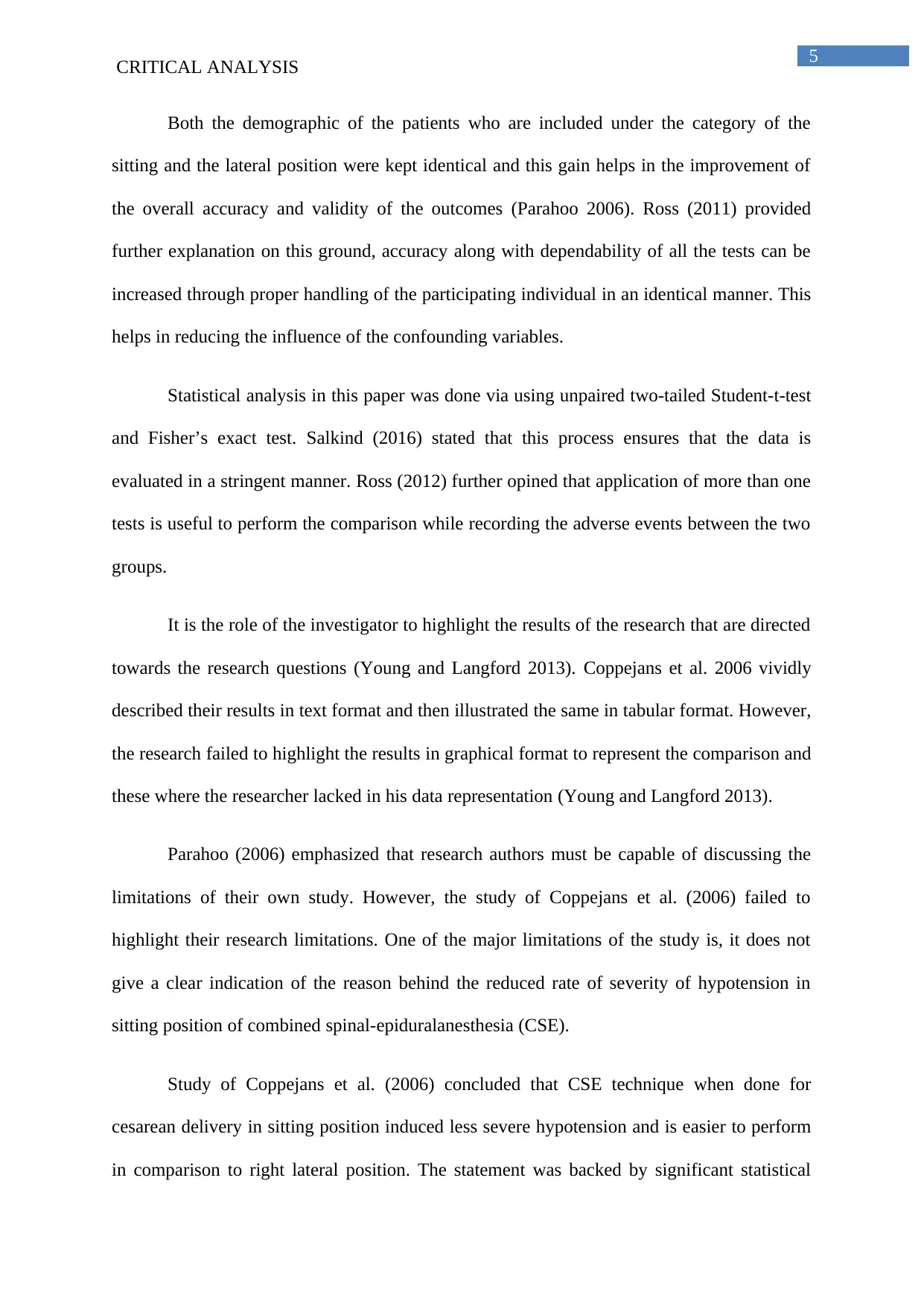
5
CRITICAL ANALYSIS
Both the demographic of the patients who are included under the category of the
sitting and the lateral position were kept identical and this gain helps in the improvement of
the overall accuracy and validity of the outcomes (Parahoo 2006). Ross (2011) provided
further explanation on this ground, accuracy along with dependability of all the tests can be
increased through proper handling of the participating individual in an identical manner. This
helps in reducing the influence of the confounding variables.
Statistical analysis in this paper was done via using unpaired two-tailed Student-t-test
and Fisher’s exact test. Salkind (2016) stated that this process ensures that the data is
evaluated in a stringent manner. Ross (2012) further opined that application of more than one
tests is useful to perform the comparison while recording the adverse events between the two
groups.
It is the role of the investigator to highlight the results of the research that are directed
towards the research questions (Young and Langford 2013). Coppejans et al. 2006 vividly
described their results in text format and then illustrated the same in tabular format. However,
the research failed to highlight the results in graphical format to represent the comparison and
these where the researcher lacked in his data representation (Young and Langford 2013).
Parahoo (2006) emphasized that research authors must be capable of discussing the
limitations of their own study. However, the study of Coppejans et al. (2006) failed to
highlight their research limitations. One of the major limitations of the study is, it does not
give a clear indication of the reason behind the reduced rate of severity of hypotension in
sitting position of combined spinal-epiduralanesthesia (CSE).
Study of Coppejans et al. (2006) concluded that CSE technique when done for
cesarean delivery in sitting position induced less severe hypotension and is easier to perform
in comparison to right lateral position. The statement was backed by significant statistical
CRITICAL ANALYSIS
Both the demographic of the patients who are included under the category of the
sitting and the lateral position were kept identical and this gain helps in the improvement of
the overall accuracy and validity of the outcomes (Parahoo 2006). Ross (2011) provided
further explanation on this ground, accuracy along with dependability of all the tests can be
increased through proper handling of the participating individual in an identical manner. This
helps in reducing the influence of the confounding variables.
Statistical analysis in this paper was done via using unpaired two-tailed Student-t-test
and Fisher’s exact test. Salkind (2016) stated that this process ensures that the data is
evaluated in a stringent manner. Ross (2012) further opined that application of more than one
tests is useful to perform the comparison while recording the adverse events between the two
groups.
It is the role of the investigator to highlight the results of the research that are directed
towards the research questions (Young and Langford 2013). Coppejans et al. 2006 vividly
described their results in text format and then illustrated the same in tabular format. However,
the research failed to highlight the results in graphical format to represent the comparison and
these where the researcher lacked in his data representation (Young and Langford 2013).
Parahoo (2006) emphasized that research authors must be capable of discussing the
limitations of their own study. However, the study of Coppejans et al. (2006) failed to
highlight their research limitations. One of the major limitations of the study is, it does not
give a clear indication of the reason behind the reduced rate of severity of hypotension in
sitting position of combined spinal-epiduralanesthesia (CSE).
Study of Coppejans et al. (2006) concluded that CSE technique when done for
cesarean delivery in sitting position induced less severe hypotension and is easier to perform
in comparison to right lateral position. The statement was backed by significant statistical
⊘ This is a preview!⊘
Do you want full access?
Subscribe today to unlock all pages.

Trusted by 1+ million students worldwide
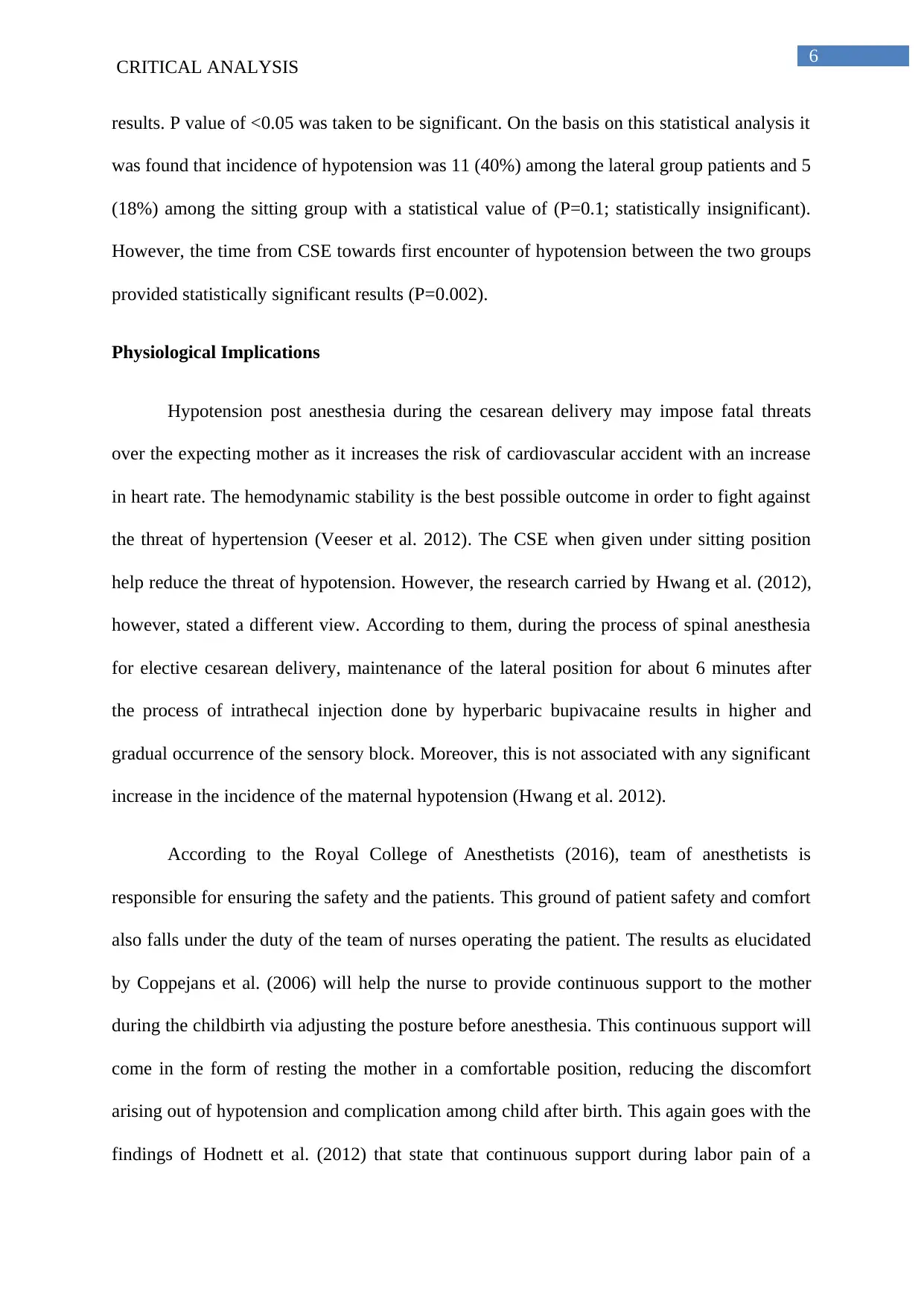
6
CRITICAL ANALYSIS
results. P value of <0.05 was taken to be significant. On the basis on this statistical analysis it
was found that incidence of hypotension was 11 (40%) among the lateral group patients and 5
(18%) among the sitting group with a statistical value of (P=0.1; statistically insignificant).
However, the time from CSE towards first encounter of hypotension between the two groups
provided statistically significant results (P=0.002).
Physiological Implications
Hypotension post anesthesia during the cesarean delivery may impose fatal threats
over the expecting mother as it increases the risk of cardiovascular accident with an increase
in heart rate. The hemodynamic stability is the best possible outcome in order to fight against
the threat of hypertension (Veeser et al. 2012). The CSE when given under sitting position
help reduce the threat of hypotension. However, the research carried by Hwang et al. (2012),
however, stated a different view. According to them, during the process of spinal anesthesia
for elective cesarean delivery, maintenance of the lateral position for about 6 minutes after
the process of intrathecal injection done by hyperbaric bupivacaine results in higher and
gradual occurrence of the sensory block. Moreover, this is not associated with any significant
increase in the incidence of the maternal hypotension (Hwang et al. 2012).
According to the Royal College of Anesthetists (2016), team of anesthetists is
responsible for ensuring the safety and the patients. This ground of patient safety and comfort
also falls under the duty of the team of nurses operating the patient. The results as elucidated
by Coppejans et al. (2006) will help the nurse to provide continuous support to the mother
during the childbirth via adjusting the posture before anesthesia. This continuous support will
come in the form of resting the mother in a comfortable position, reducing the discomfort
arising out of hypotension and complication among child after birth. This again goes with the
findings of Hodnett et al. (2012) that state that continuous support during labor pain of a
CRITICAL ANALYSIS
results. P value of <0.05 was taken to be significant. On the basis on this statistical analysis it
was found that incidence of hypotension was 11 (40%) among the lateral group patients and 5
(18%) among the sitting group with a statistical value of (P=0.1; statistically insignificant).
However, the time from CSE towards first encounter of hypotension between the two groups
provided statistically significant results (P=0.002).
Physiological Implications
Hypotension post anesthesia during the cesarean delivery may impose fatal threats
over the expecting mother as it increases the risk of cardiovascular accident with an increase
in heart rate. The hemodynamic stability is the best possible outcome in order to fight against
the threat of hypertension (Veeser et al. 2012). The CSE when given under sitting position
help reduce the threat of hypotension. However, the research carried by Hwang et al. (2012),
however, stated a different view. According to them, during the process of spinal anesthesia
for elective cesarean delivery, maintenance of the lateral position for about 6 minutes after
the process of intrathecal injection done by hyperbaric bupivacaine results in higher and
gradual occurrence of the sensory block. Moreover, this is not associated with any significant
increase in the incidence of the maternal hypotension (Hwang et al. 2012).
According to the Royal College of Anesthetists (2016), team of anesthetists is
responsible for ensuring the safety and the patients. This ground of patient safety and comfort
also falls under the duty of the team of nurses operating the patient. The results as elucidated
by Coppejans et al. (2006) will help the nurse to provide continuous support to the mother
during the childbirth via adjusting the posture before anesthesia. This continuous support will
come in the form of resting the mother in a comfortable position, reducing the discomfort
arising out of hypotension and complication among child after birth. This again goes with the
findings of Hodnett et al. (2012) that state that continuous support during labor pain of a
Paraphrase This Document
Need a fresh take? Get an instant paraphrase of this document with our AI Paraphraser
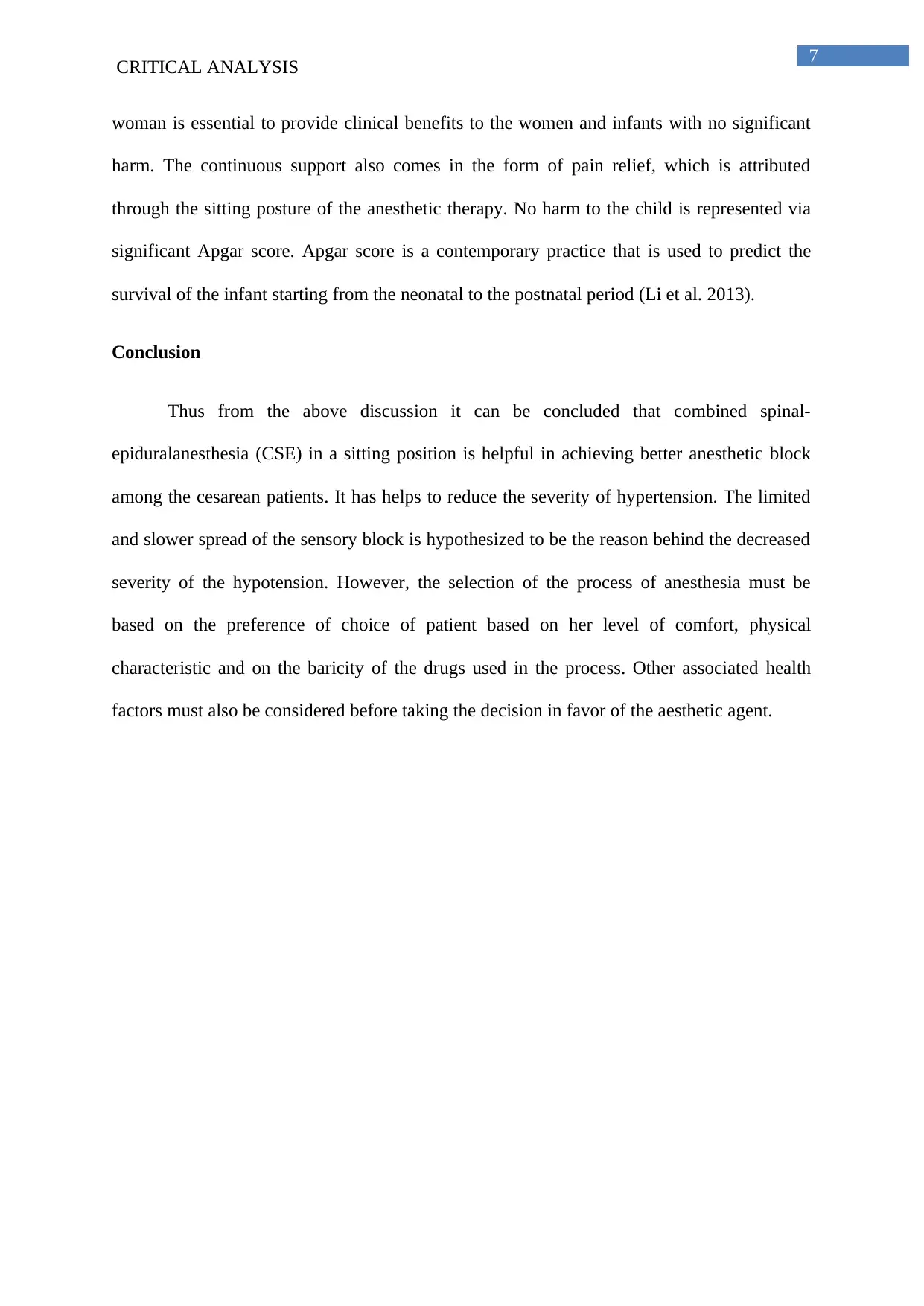
7
CRITICAL ANALYSIS
woman is essential to provide clinical benefits to the women and infants with no significant
harm. The continuous support also comes in the form of pain relief, which is attributed
through the sitting posture of the anesthetic therapy. No harm to the child is represented via
significant Apgar score. Apgar score is a contemporary practice that is used to predict the
survival of the infant starting from the neonatal to the postnatal period (Li et al. 2013).
Conclusion
Thus from the above discussion it can be concluded that combined spinal-
epiduralanesthesia (CSE) in a sitting position is helpful in achieving better anesthetic block
among the cesarean patients. It has helps to reduce the severity of hypertension. The limited
and slower spread of the sensory block is hypothesized to be the reason behind the decreased
severity of the hypotension. However, the selection of the process of anesthesia must be
based on the preference of choice of patient based on her level of comfort, physical
characteristic and on the baricity of the drugs used in the process. Other associated health
factors must also be considered before taking the decision in favor of the aesthetic agent.
CRITICAL ANALYSIS
woman is essential to provide clinical benefits to the women and infants with no significant
harm. The continuous support also comes in the form of pain relief, which is attributed
through the sitting posture of the anesthetic therapy. No harm to the child is represented via
significant Apgar score. Apgar score is a contemporary practice that is used to predict the
survival of the infant starting from the neonatal to the postnatal period (Li et al. 2013).
Conclusion
Thus from the above discussion it can be concluded that combined spinal-
epiduralanesthesia (CSE) in a sitting position is helpful in achieving better anesthetic block
among the cesarean patients. It has helps to reduce the severity of hypertension. The limited
and slower spread of the sensory block is hypothesized to be the reason behind the decreased
severity of the hypotension. However, the selection of the process of anesthesia must be
based on the preference of choice of patient based on her level of comfort, physical
characteristic and on the baricity of the drugs used in the process. Other associated health
factors must also be considered before taking the decision in favor of the aesthetic agent.
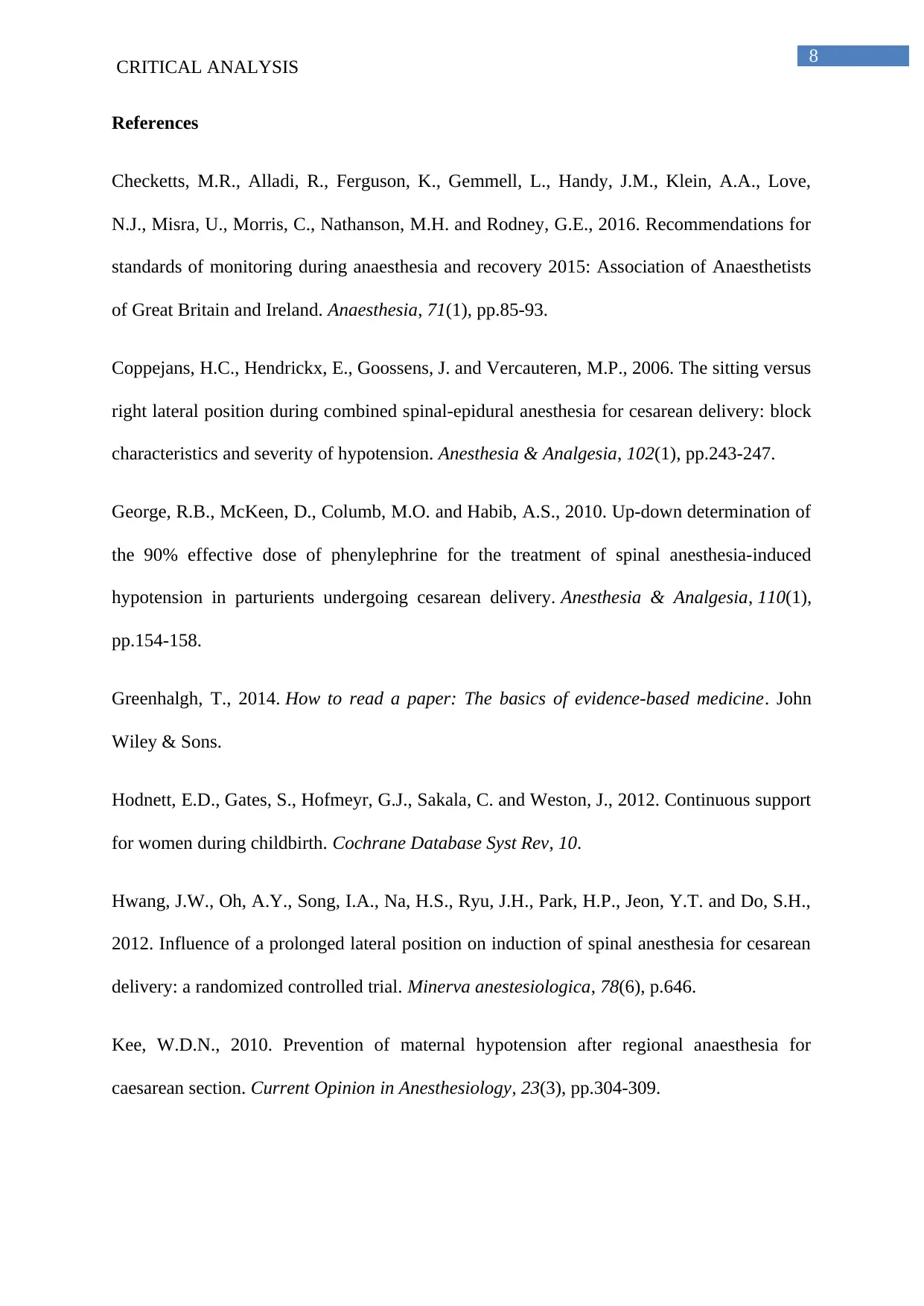
8
CRITICAL ANALYSIS
References
Checketts, M.R., Alladi, R., Ferguson, K., Gemmell, L., Handy, J.M., Klein, A.A., Love,
N.J., Misra, U., Morris, C., Nathanson, M.H. and Rodney, G.E., 2016. Recommendations for
standards of monitoring during anaesthesia and recovery 2015: Association of Anaesthetists
of Great Britain and Ireland. Anaesthesia, 71(1), pp.85-93.
Coppejans, H.C., Hendrickx, E., Goossens, J. and Vercauteren, M.P., 2006. The sitting versus
right lateral position during combined spinal-epidural anesthesia for cesarean delivery: block
characteristics and severity of hypotension. Anesthesia & Analgesia, 102(1), pp.243-247.
George, R.B., McKeen, D., Columb, M.O. and Habib, A.S., 2010. Up-down determination of
the 90% effective dose of phenylephrine for the treatment of spinal anesthesia-induced
hypotension in parturients undergoing cesarean delivery. Anesthesia & Analgesia, 110(1),
pp.154-158.
Greenhalgh, T., 2014. How to read a paper: The basics of evidence-based medicine. John
Wiley & Sons.
Hodnett, E.D., Gates, S., Hofmeyr, G.J., Sakala, C. and Weston, J., 2012. Continuous support
for women during childbirth. Cochrane Database Syst Rev, 10.
Hwang, J.W., Oh, A.Y., Song, I.A., Na, H.S., Ryu, J.H., Park, H.P., Jeon, Y.T. and Do, S.H.,
2012. Influence of a prolonged lateral position on induction of spinal anesthesia for cesarean
delivery: a randomized controlled trial. Minerva anestesiologica, 78(6), p.646.
Kee, W.D.N., 2010. Prevention of maternal hypotension after regional anaesthesia for
caesarean section. Current Opinion in Anesthesiology, 23(3), pp.304-309.
CRITICAL ANALYSIS
References
Checketts, M.R., Alladi, R., Ferguson, K., Gemmell, L., Handy, J.M., Klein, A.A., Love,
N.J., Misra, U., Morris, C., Nathanson, M.H. and Rodney, G.E., 2016. Recommendations for
standards of monitoring during anaesthesia and recovery 2015: Association of Anaesthetists
of Great Britain and Ireland. Anaesthesia, 71(1), pp.85-93.
Coppejans, H.C., Hendrickx, E., Goossens, J. and Vercauteren, M.P., 2006. The sitting versus
right lateral position during combined spinal-epidural anesthesia for cesarean delivery: block
characteristics and severity of hypotension. Anesthesia & Analgesia, 102(1), pp.243-247.
George, R.B., McKeen, D., Columb, M.O. and Habib, A.S., 2010. Up-down determination of
the 90% effective dose of phenylephrine for the treatment of spinal anesthesia-induced
hypotension in parturients undergoing cesarean delivery. Anesthesia & Analgesia, 110(1),
pp.154-158.
Greenhalgh, T., 2014. How to read a paper: The basics of evidence-based medicine. John
Wiley & Sons.
Hodnett, E.D., Gates, S., Hofmeyr, G.J., Sakala, C. and Weston, J., 2012. Continuous support
for women during childbirth. Cochrane Database Syst Rev, 10.
Hwang, J.W., Oh, A.Y., Song, I.A., Na, H.S., Ryu, J.H., Park, H.P., Jeon, Y.T. and Do, S.H.,
2012. Influence of a prolonged lateral position on induction of spinal anesthesia for cesarean
delivery: a randomized controlled trial. Minerva anestesiologica, 78(6), p.646.
Kee, W.D.N., 2010. Prevention of maternal hypotension after regional anaesthesia for
caesarean section. Current Opinion in Anesthesiology, 23(3), pp.304-309.
⊘ This is a preview!⊘
Do you want full access?
Subscribe today to unlock all pages.

Trusted by 1+ million students worldwide

9
CRITICAL ANALYSIS
Langford, R. and Young, A., 2013. Predicting NCLEX-RN success with the HESI Exit
Exam: Eighth validity study. Journal of Professional Nursing, 29(2), pp.S5-S9.
Li, F., Wu, T., Lei, X., Zhang, H., Mao, M. and Zhang, J., 2013. The apgar score and infant
mortality. PloS one, 8(7), p.e69072.
Mercier, F.J., Augè, M., Hoffmann, C., Fischer, C. and Le Gouez, A., 2013. Maternal
hypotension during spinal anesthesia for caesarean delivery. Minerva Anestesiol, 79(1),
pp.62-73.
Oh, A.Y., Hwang, J.W., Song, I.A., Kim, M.H., Ryu, J.H., Park, H.P., Jeon, Y.T. and Do,
S.H., 2014. Influence of the timing of administration of crystalloid on maternal hypotension
during spinal anesthesia for cesarean delivery: preload versus coload. BMC
anesthesiology, 14(1), p.36.
Parahoo, K. 2006. Nursing research : principles, process and issues. London: Palgrave
Macmillan
Ross, T., 2012. A survival guide for health research methods. McGraw-Hill Education (UK).
Salkind, N.J., 2016. Statistics for people who (think they) hate statistics. Sage Publications.
Simmons, S.W., Taghizadeh, N., Dennis, A.T., Hughes, D. and Cyna, A.M., 2012. Combined
spinal‐epidural versus epidural analgesia in labour. The Cochrane Library.
Suresh, K.P. and Chandrashekara, S., 2012. Sample size estimation and power analysis for
clinical research studies. Journal of human reproductive sciences, 5(1), p.7.
Thompson, I. E. et al. 2006. Nursing Ethics. 5th ed. Edinburgh ; New York: Churchill
Livingstone Elsevier.
Veeser, M., Hofmann, T., Roth, R., Klöhr, S., Rossaint, R. and Heesen, M., 2012.
Vasopressors for the management of hypotension after spinal anesthesia for elective
CRITICAL ANALYSIS
Langford, R. and Young, A., 2013. Predicting NCLEX-RN success with the HESI Exit
Exam: Eighth validity study. Journal of Professional Nursing, 29(2), pp.S5-S9.
Li, F., Wu, T., Lei, X., Zhang, H., Mao, M. and Zhang, J., 2013. The apgar score and infant
mortality. PloS one, 8(7), p.e69072.
Mercier, F.J., Augè, M., Hoffmann, C., Fischer, C. and Le Gouez, A., 2013. Maternal
hypotension during spinal anesthesia for caesarean delivery. Minerva Anestesiol, 79(1),
pp.62-73.
Oh, A.Y., Hwang, J.W., Song, I.A., Kim, M.H., Ryu, J.H., Park, H.P., Jeon, Y.T. and Do,
S.H., 2014. Influence of the timing of administration of crystalloid on maternal hypotension
during spinal anesthesia for cesarean delivery: preload versus coload. BMC
anesthesiology, 14(1), p.36.
Parahoo, K. 2006. Nursing research : principles, process and issues. London: Palgrave
Macmillan
Ross, T., 2012. A survival guide for health research methods. McGraw-Hill Education (UK).
Salkind, N.J., 2016. Statistics for people who (think they) hate statistics. Sage Publications.
Simmons, S.W., Taghizadeh, N., Dennis, A.T., Hughes, D. and Cyna, A.M., 2012. Combined
spinal‐epidural versus epidural analgesia in labour. The Cochrane Library.
Suresh, K.P. and Chandrashekara, S., 2012. Sample size estimation and power analysis for
clinical research studies. Journal of human reproductive sciences, 5(1), p.7.
Thompson, I. E. et al. 2006. Nursing Ethics. 5th ed. Edinburgh ; New York: Churchill
Livingstone Elsevier.
Veeser, M., Hofmann, T., Roth, R., Klöhr, S., Rossaint, R. and Heesen, M., 2012.
Vasopressors for the management of hypotension after spinal anesthesia for elective
Paraphrase This Document
Need a fresh take? Get an instant paraphrase of this document with our AI Paraphraser
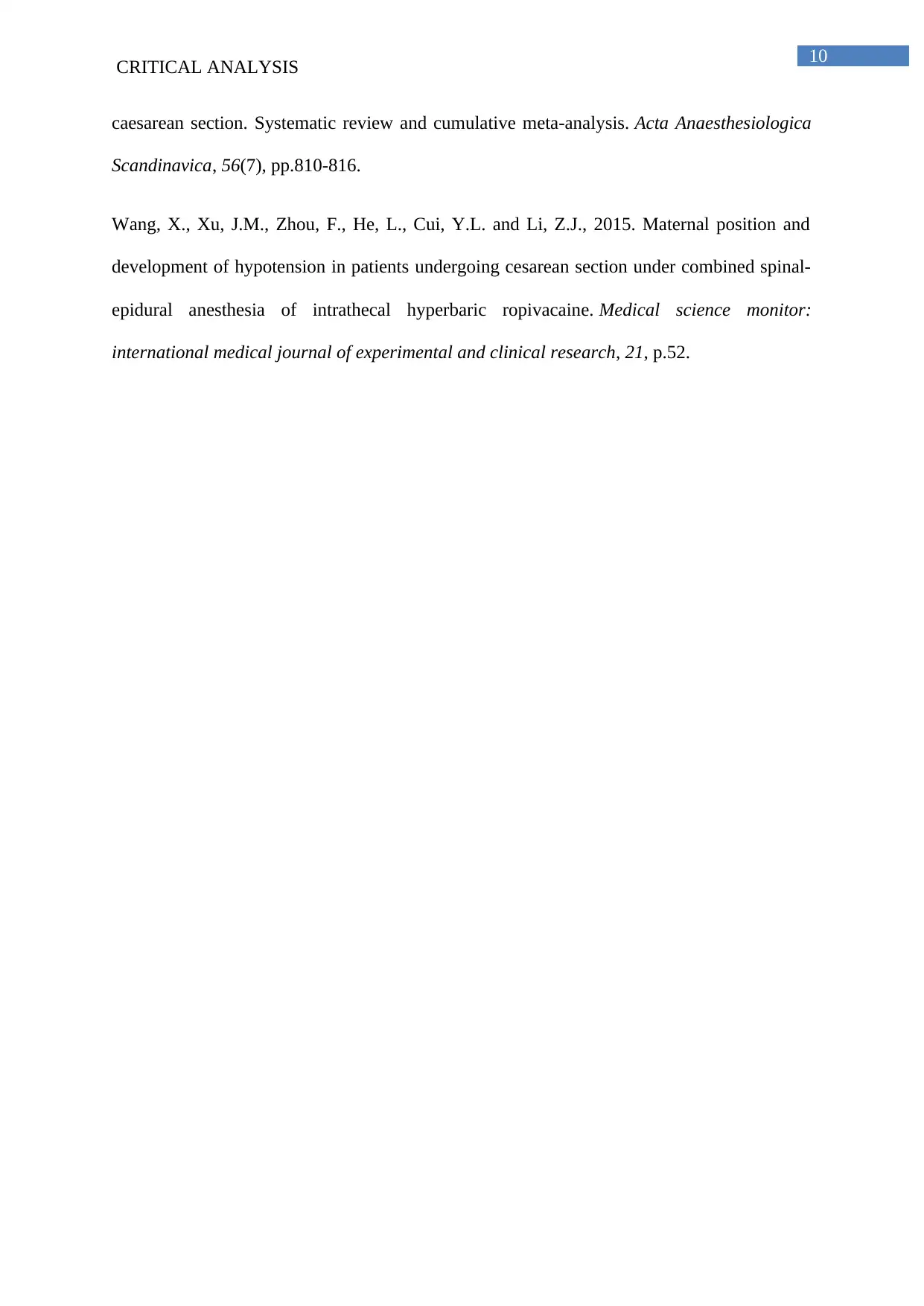
10
CRITICAL ANALYSIS
caesarean section. Systematic review and cumulative meta‐analysis. Acta Anaesthesiologica
Scandinavica, 56(7), pp.810-816.
Wang, X., Xu, J.M., Zhou, F., He, L., Cui, Y.L. and Li, Z.J., 2015. Maternal position and
development of hypotension in patients undergoing cesarean section under combined spinal-
epidural anesthesia of intrathecal hyperbaric ropivacaine. Medical science monitor:
international medical journal of experimental and clinical research, 21, p.52.
CRITICAL ANALYSIS
caesarean section. Systematic review and cumulative meta‐analysis. Acta Anaesthesiologica
Scandinavica, 56(7), pp.810-816.
Wang, X., Xu, J.M., Zhou, F., He, L., Cui, Y.L. and Li, Z.J., 2015. Maternal position and
development of hypotension in patients undergoing cesarean section under combined spinal-
epidural anesthesia of intrathecal hyperbaric ropivacaine. Medical science monitor:
international medical journal of experimental and clinical research, 21, p.52.
1 out of 11
Your All-in-One AI-Powered Toolkit for Academic Success.
+13062052269
info@desklib.com
Available 24*7 on WhatsApp / Email
![[object Object]](/_next/static/media/star-bottom.7253800d.svg)
Unlock your academic potential
Copyright © 2020–2025 A2Z Services. All Rights Reserved. Developed and managed by ZUCOL.

